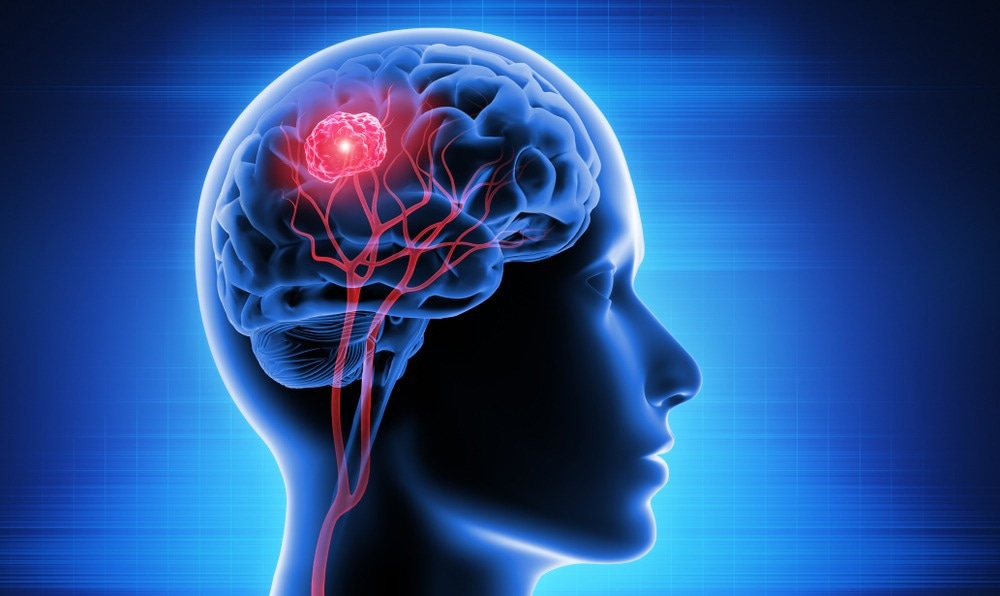Malignant brain tumors are cancerous growth in the brain with the possibility of spreading to other parts of the central nervous system (CNS). Brain tumors are highly invasive and have devastating consequences, poor prognosis, and low survival rates.

Study: Multifunctional nanotheranostics for near infrared optical imaging-guided treatment of brain tumors. Image Credit: peterschreiber.media/Shutterstock.com
Recently, the noninvasive near-infrared fluorescence and photoacoustic imaging techniques have demonstrated a bright scope in brain tumor diagnosis with high spatiotemporal resolution, large penetration depth, and good sensitivity. Hence, these imaging techniques have been used to guide real-time brain tumor therapy with high efficiency and accuracy.
An article published in the journal Advanced Drug Delivery Reviews presented a summary of state-of-art near-infrared contrast agents (CAs) and optical imaging-guided therapies for brain tumor imaging. Finally, the opportunities and challenges involved in the use of CAs and nanotheranostics for future clinical translation were discussed.
Near-Infrared Fluorescence Imaging of Brain Tumors
The brain tumor is an intracranial neoplasm in the brain or the central spinal canal. An abnormal and uncontrolled cell division, usually in the brain, involving neurons or glial cells or occasionally in the lymphatic tissue, blood vessels, and others, is the main leading cause of the formation of primary brain tumors. The majority of the brain tumors in adults are secondary or metastatic tumors, that is, cancers primarily located in other organs and may spread to the brain and create brain tumors.
Diagnosis of brain tumors is the critical step for effective curing of the disease, and it vividly relies on the advancements in molecular imaging technology. Although various imaging modalities, including magnetic resonance imaging (MRI), positron emission tomography (PET) imaging, and computed tomography (CT) imaging were investigated for the detection of brain tumors, these modalities possess several limitations.
In this regard, fluorescence imaging is a method that relies on fluorescence, absorption, bioluminescence, and reflectance resulting from various fluorescent nanomaterials used for visualizing the brain microstructures and monitoring the tumor progression.
Nevertheless, the effectiveness and safety of fluorescence imaging, using visible light for fluorescence imaging, displayed limited penetration of the light and resulted in decreased light-tissue interactions. Light in the near-infrared range (wavelength: 650–900 nanometers) has several advantages over visible-range light, including deeper tissue penetration due to less absorption by hemoglobin and water and less autofluorescence from surrounding tissues. Consequently, a new scope has emerged for near-infrared fluorescence imaging for detecting and treating brain tumors.
Near-infrared fluorescence imaging of brain tumors is a growing field for preclinical and clinical applications in clinical management due to its advantageous features, including a high spatial resolution, portability, real-time display, and detailed molecular profiling with the multiplexed use of fluorescent probes.
Similarly, near-infrared photoacoustic imaging (PAI) is a noninvasive imaging technique that involves acoustic waves as the emission source. It combines the advantages of ultrasonic and optical energies to realize biological imaging with deep tissue penetration depth. Thus, making PAI a promising diagnosis technique.
Near Infrared Optical Imaging-Guided Treatment of Brain Tumors
Near-infrared optical imaging-guided brain tumor therapy has been used in theranostics. Various therapeutic functions have been demonstrated with the assistance of near-infrared fluorescence imaging and PAI.
Despite encouraging progress, several obstacles remain in transitioning optical imaging techniques to clinical applications. As safety is the primary concern for the clinical translation of nanomedicine, nanotheranostics and nanoprobes are subjected to various surface modifications using biocompatible polymers to reduce their toxicities.
Near-infrared fluorescence imaging and PAI have vividly helped in the diagnosis of cancer. However, the presence of the skull and scalp hampers the quality of light and the imaging of brain tumors. This suggests that the second near-infrared region (NIR-II) can increase tissue penetration and depth while decreasing light scattering and enhancing the signal-to-background ratio. Consequently, deep-seated brain tumors can also be diagnosed.
CAs with excited-state intramolecular motion have good prospects for fine-tuning the balance between nonradiative and radiative decay in dual-mode near-infrared fluorescence imaging or PAI. Near-infrared fluorescence imaging CAs, including organic dyes, semiconducting polymer dots, aggregation-induced emission luminous, and inorganic (quantum dots and rare-earth nanoparticles) probes, have been investigated for the diagnosis of brain tumors.
Conclusion
Overall, multimodal optical imaging techniques can decrease misdiagnosis rates of brain tumors and provide functional and anatomical information. Moreover, theranostic agent-based imaging guidance and combination treatment can enhance the treatment outcomes of brain tumors and reduce side effects.
Furthermore, nanoparticles less than 5 nanometers in size are favorable for renal excretion and reduce toxicity during treatment. Thus, the fabrication of biodegradable nanomaterials followed by toxicity evaluations can increase the clinical success of treatment.
In the case of brain tumors, the blood-brain barrier restricts the entry of nanoagents into brain tissues. In this regard, peptides with targeting abilities and focused ultrasound (FUS) assistance can help deliver nanoagents to brain tumors for diagnosis and therapy.
Reference
Zhang, L et al. (2022). Multifunctional nanotheranostics for near infrared optical imaging-guided treatment of brain tumors. Advanced Drug Delivery Reviews. https://www.sciencedirect.com/science/article/pii/S0169409X22004264?via%3Dihub
Disclaimer: The views expressed here are those of the author expressed in their private capacity and do not necessarily represent the views of AZoM.com Limited T/A AZoNetwork the owner and operator of this website. This disclaimer forms part of the Terms and conditions of use of this website.